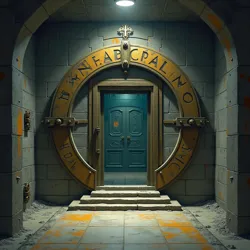Hadal Archives
The Hadal Archives represent one of the most comprehensive collections of deep-sea archaeological documentation in existence, housed within a series of climate-controlled vaults beneath the Northern Peninsula Engineering Complex. Established in 1928 by the Abyssal Heritage Foundation, the archives have grown from a modest collection of underwater photographs into an extensive repository of maritime artifacts, technical documents, and photographic evidence that challenges conventional understanding of pre-classical naval engineering capabilities.
 The main entrance to the Hadal Archives' preservation chamber, featuring distinctive pressure-sealed doors based on ancient designs
The main entrance to the Hadal Archives' preservation chamber, featuring distinctive pressure-sealed doors based on ancient designsHistory and Foundation
The archives originated from an unprecedented discovery during the Maritime Pressure Studies expedition of 1927, when researchers first documented extensive underwater structures that appeared to predate known civilization. Dr. Eleanor Hadal, the expedition's lead researcher, recognized the need for a dedicated facility to preserve and study these findings. Working in collaboration with the Vale Harbor Naval Engineering District, she established the archive system that would later bear her name.
The initial collection consisted primarily of glass plate negatives and brass-encased underwater cameras specially designed to withstand extreme depths. These early photographic devices, based partly on principles found in the Deepwater Tablets, allowed researchers to document architectural features and inscriptions at depths previously thought impossible to reach with contemporary technology.
Facility and Infrastructure
The archives occupy three underground levels beneath Vale Harbor's northern peninsula, with the deepest vault situated 200 feet below sea level. The facility's unique architecture incorporates elements of ancient pressure-management systems discovered in submerged ruins along the Pacific Rim. The main preservation chamber employs a sophisticated environmental control system that maintains precise temperature and humidity levels necessary for the preservation of recovered artifacts and photographic materials.
Special consideration has been given to protecting the archives' contents from seawater intrusion, utilizing innovative sealing techniques that mirror those found documented in pre-classical maritime engineering texts. The facility's design drew heavily from specifications uncovered during the Vale Harbor Bathysphere Incident, particularly in its approach to managing hydrostatic pressure at extreme depths.
Collections and Holdings
Photographic Documentation
The archives' cornerstone collection includes over 4,000 underwater photographs documenting previously unknown architectural structures on the ocean floor. These images, captured between 1928 and the present day, provide compelling evidence of advanced maritime engineering capabilities in ancient civilizations. The photographic collection has been instrumental in supporting the Benthic Engineering Theory, particularly through its documentation of sophisticated underwater construction techniques.
Technical Documents
A significant portion of the archives consists of technical drawings, engineering specifications, and mathematical calculations relating to deep-sea construction methods. Many of these documents show striking similarities to ancient inscriptions found during the Trench Expedition Findings, suggesting a continuous lineage of maritime engineering knowledge stretching back millennia.
Artifact Repository
The archives maintain a sealed vault containing recovered artifacts from various deep-sea excavations. These items include examples of early pressure-resistant materials, navigation instruments, and architectural components that demonstrate advanced understanding of underwater engineering principles. Of particular interest is the Hadal Collection of Pressure Seals, which includes examples of ancient water-tight joining techniques that remain effective even under extreme conditions.
Research Programs
The Hadal Archives support numerous ongoing research initiatives, including the comprehensive documentation of submerged architectural features through the Underwater Structure Mapping Project. The facility's research programs have been instrumental in establishing connections between modern naval engineering practices and pre-classical maritime technology.
Collaborative studies conducted at the archives have led to significant breakthroughs in understanding ancient underwater construction techniques. These findings have influenced modern submarine design, particularly in the development of pressure-resistant hull configurations studied by Chen & Associates Naval Design.
Recent Developments
The archives recently underwent a major expansion as part of the Hadal Archives Expansion Project, which added new storage capacity and advanced preservation systems. This expansion was prompted by the discovery of extensive underwater ruins during recent deep-sea expeditions, necessitating additional space for artifact storage and documentation.
Access and Security
Access to the Hadal Archives is strictly controlled, with different security clearance levels required for various sections of the facility. Research access is granted through a rigorous application process overseen by the Deep Sea Research Council, a newly established oversight body composed of leading marine archaeologists and naval engineers.
Impact on Maritime Engineering
The archives have played a crucial role in advancing understanding of both historical and contemporary underwater engineering principles. Findings preserved within the facility have influenced modern submarine design, deep-sea construction techniques, and understanding of pressure-resistant materials. The documentation housed in the archives continues to provide valuable insights into pre-classical maritime engineering capabilities, challenging conventional assumptions about the technological achievements of ancient civilizations.
See Also
- Vale Harbor Technical Drawing Repository
- Subsea Construction Techniques Database
- Maritime Archaeological Survey Database
References
- Benthic Engineering Principles
- Pre-Classical Maritime Mathematics
- Maritime Engineering Chronology